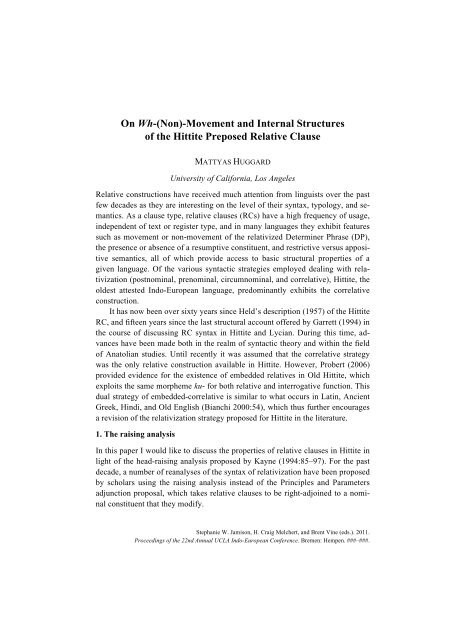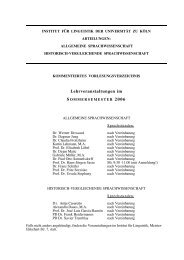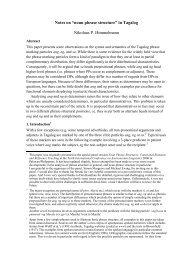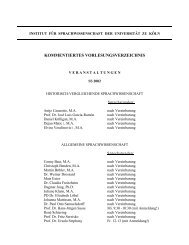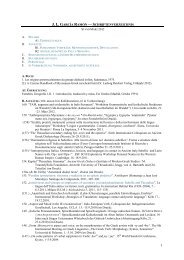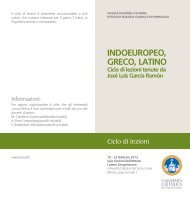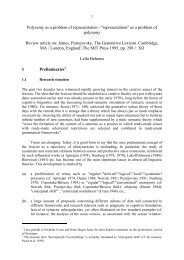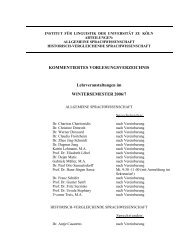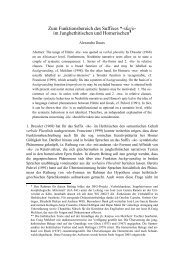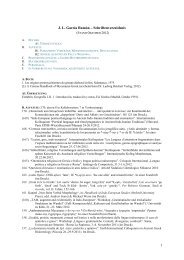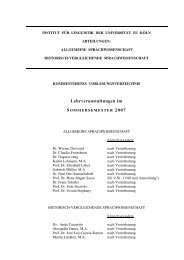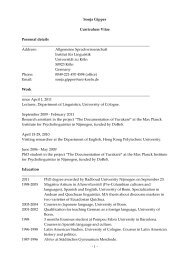Topics in Anatolian Historical Grammar Prof. Dr. H. Craig Melchert
Topics in Anatolian Historical Grammar Prof. Dr. H. Craig Melchert
Topics in Anatolian Historical Grammar Prof. Dr. H. Craig Melchert
Create successful ePaper yourself
Turn your PDF publications into a flip-book with our unique Google optimized e-Paper software.
On Wh-(Non)-Movement and Internal Structures<br />
of the Hittite Preposed Relative Clause<br />
MATTYAS HUGGARD<br />
University of California, Los Angeles<br />
Relative constructions have received much attention from l<strong>in</strong>guists over the past<br />
few decades as they are <strong>in</strong>terest<strong>in</strong>g on the level of their syntax, typology, and semantics.<br />
As a clause type, relative clauses (RCs) have a high frequency of usage,<br />
<strong>in</strong>dependent of text or register type, and <strong>in</strong> many languages they exhibit features<br />
such as movement or non-movement of the relativized Determ<strong>in</strong>er Phrase (DP),<br />
the presence or absence of a resumptive constituent, and restrictive versus appositive<br />
semantics, all of which provide access to basic structural properties of a<br />
given language. Of the various syntactic strategies employed deal<strong>in</strong>g with relativization<br />
(postnom<strong>in</strong>al, prenom<strong>in</strong>al, circumnom<strong>in</strong>al, and correlative), Hittite, the<br />
oldest attested Indo-European language, predom<strong>in</strong>antly exhibits the correlative<br />
construction.<br />
It has now been over sixty years s<strong>in</strong>ce Held’s description (1957) of the Hittite<br />
RC, and fifteen years s<strong>in</strong>ce the last structural account offered by Garrett (1994) <strong>in</strong><br />
the course of discuss<strong>in</strong>g RC syntax <strong>in</strong> Hittite and Lycian. Dur<strong>in</strong>g this time, advances<br />
have been made both <strong>in</strong> the realm of syntactic theory and with<strong>in</strong> the field<br />
of <strong>Anatolian</strong> studies. Until recently it was assumed that the correlative strategy<br />
was the only relative construction available <strong>in</strong> Hittite. However, Probert (2006)<br />
provided evidence for the existence of embedded relatives <strong>in</strong> Old Hittite, which<br />
exploits the same morpheme ku- for both relative and <strong>in</strong>terrogative function. This<br />
dual strategy of embedded-correlative is similar to what occurs <strong>in</strong> Lat<strong>in</strong>, Ancient<br />
Greek, H<strong>in</strong>di, and Old English (Bianchi 2000:54), which thus further encourages<br />
a revision of the relativization strategy proposed for Hittite <strong>in</strong> the literature.<br />
1. The rais<strong>in</strong>g analysis<br />
In this paper I would like to discuss the properties of relative clauses <strong>in</strong> Hittite <strong>in</strong><br />
light of the head-rais<strong>in</strong>g analysis proposed by Kayne (1994:85–97). For the past<br />
decade, a number of reanalyses of the syntax of relativization have been proposed<br />
by scholars us<strong>in</strong>g the rais<strong>in</strong>g analysis <strong>in</strong>stead of the Pr<strong>in</strong>ciples and Parameters<br />
adjunction proposal, which takes relative clauses to be right-adjo<strong>in</strong>ed to a nom<strong>in</strong>al<br />
constituent that they modify.<br />
Stephanie W. Jamison, H. <strong>Craig</strong> <strong>Melchert</strong>, and Brent V<strong>in</strong>e (eds.). 2011.<br />
Proceed<strong>in</strong>gs of the 22nd Annual UCLA Indo-European Conference. Bremen: Hempen. ###–###.


